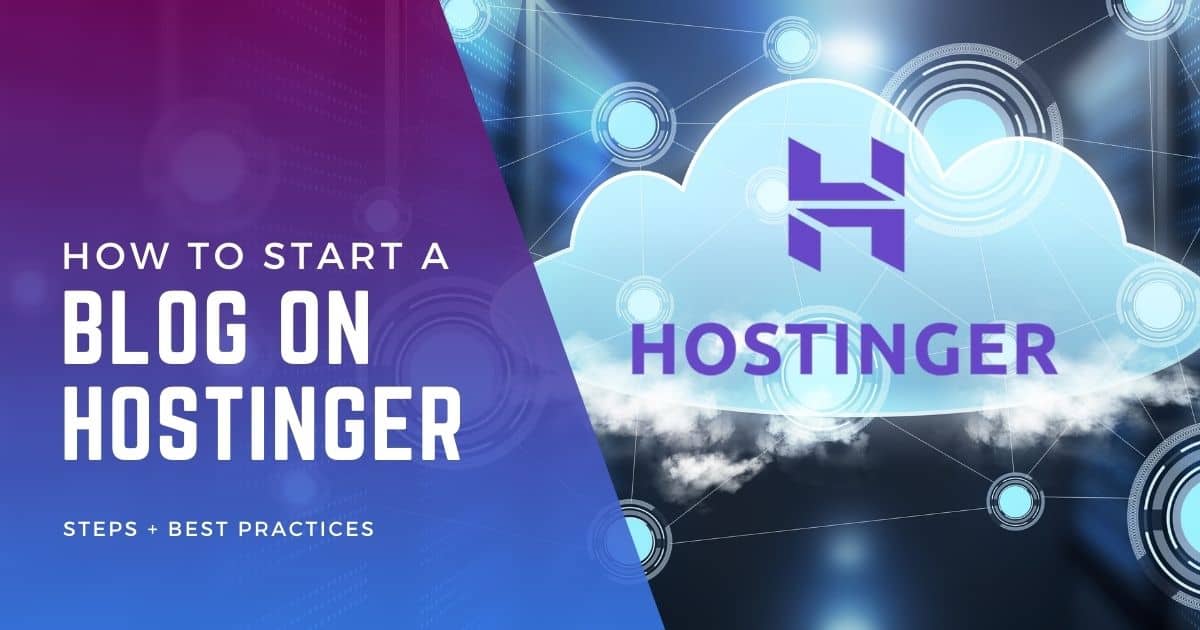Starting a blog can seem intimidating, but with Hostinger, it’s easy. Their user-friendly tools help you launch a site quickly. But you may still have questions—how to choose a domain, which plugins to use, and how to optimize for SEO. These are common concerns for beginners. Hostinger provides the ideal platform for first-time bloggers with the right guidance to get your blog off the ground successfully.
The good news is that starting a blog on Hostinger is straightforward, with the right information. As an experienced blogger and technology expert, I have launched multiple sites using Hostinger’s technology. I have spent considerable time navigating the platform’s tools to build, manage, and grow successful blogs across niches. I will share the precise steps to start a blog on Hostinger based on proven techniques that deliver results.
You’ll learn insider tips to select the ideal domain, install essential WordPress plugins, optimize SEO, and attract readers consistently. I will walk you through every aspect from start to finish, providing easy-to-follow instructions tailored for Hostinger. You’ll learn to launch your blog confidently and expand your reach. Let’s get started on making your blogging ambitions a reality!
Signing Up for Hostinger and Utilizing Hostinger Academy
Signing up for Hostinger is your first step to launching a successful online presence, but don’t stop there. Leveraging Hostinger Academy gives you access to essential tips and guides that can fast-track your success. Trust me, combining these two elements can be a game-changer for your online ventures.
How to sign up for an account on Hostinger
Signing up for an account on Hostinger is a straightforward process that lets you start your blog quickly. Here’s a step-by-step guide:
- Visit the Hostinger website and click on the “Get Started” button.
- Choose a hosting plan that suits your needs. Hostinger offers various options, including shared hosting, cloud hosting, and VPS hosting.
- Select a domain name or transfer an existing one to Hostinger. A domain name is your blog’s unique web address.
- Fill in your personal information and create an account using your email address and password.
- Review your order details and complete the payment process.
Once you’ve signed up for an account, you’ll gain access to a user-friendly dashboard where you can manage your website, install blogging platforms like WordPress, and explore additional features offered by Hostinger.
Exploring the features and benefits of Hostinger Academy

Hostinger Academy is a fantastic resource designed to help bloggers enhance their skills and knowledge in various areas of blogging. Let’s take a closer look at some of its key features:
- Online courses: Hostinger Academy provides many online courses tailored specifically for bloggers. These courses cover content creation, SEO optimization, monetization strategies, social media marketing, and more.
- Valuable resources for blogging: In addition to courses, the academy offers e-books, guides, templates, and checklists that can assist you in different aspects of running a successful blog on WordPress. These resources are particularly helpful regarding web hosting and making money from your blog.
- Expert instructors: The academy collaborates with industry experts who share their insights and expertise through video tutorials and written content.
- Interactive learning: The blogging platform encourages interaction among learners through forums and discussion boards where you can connect with fellow bloggers facing similar challenges in the WordPress and web hosting community. Share your experiences and get valuable insights to enhance your blog posts.
By utilizing the Hostinger Academy, you can acquire new skills, stay updated with the latest trends in blogging, and gain a competitive edge in the online sphere.
Accessing valuable resources and tutorials to enhance your blogging skills
Hostinger Academy provides extensive resources and tutorials to enhance your blogging skills significantly. Here are some examples of what you can find:
- SEO optimization techniques: Learn how to optimize your blog posts for search engines, increase organic traffic, and improve your website’s visibility.
- Content creation strategies: Discover effective methods for creating engaging and compelling content that resonates with your target audience.
- Monetization strategies for your blogging site: Explore different ways to monetize your WordPress blog, such as affiliate marketing, sponsored posts, advertising networks, and more, with the help of reliable web hosting.
Choosing the Right Blogging Platform
One of the first decisions you must make is choosing the right blogging platform. With several options available, it’s important to consider various factors before selecting.
Comparing different blogging platforms available on Hostinger
Hostinger offers various blogging platforms catering to different needs and preferences. Let’s take a closer look at some popular options:
- WordPress: WordPress is a widely used content management system (CMS) that powers millions of websites worldwide. It provides flexibility, easy customization, and access to many plugins for added functionality.
- Website Builders: Hostinger also offers website builders like Zyro and Zyro Builder, which provide intuitive drag-and-drop interfaces for building your blog without coding knowledge.
- Other CMS Options: If you’re looking for alternatives to WordPress, Hostinger also supports other CMS platforms such as Joomla and Drupal.
Each platform has its own features and functionalities, so it’s essential to compare them based on your specific requirements.
Factors to consider when selecting the best platform for your blog
To choose the right blogging platform on Hostinger, consider the following factors:
- Ease of Use: If you’re new to blogging or have limited technical skills, opt for a user-friendly platform with an intuitive interface that simplifies blog creation and management.
- Customization Options: Look for platforms that offer extensive customization options regarding themes, layouts, colors, fonts, and more. This ensures that your blog reflects your unique style and branding.
- Scalability: Consider whether the platform allows room for growth as your blog expands in terms of traffic and content volume. Ensure that it can handle increased demands without compromising performance.
- Plugin Support: Plugins enhance the functionality of your blog by offering additional features such as SEO optimization, social media integration, and analytics. Check if the platform supports various plugins to meet your specific needs.
Understanding the advantages and disadvantages of each platform option
To make an informed decision, it’s crucial to weigh the pros and cons of each blogging platform on Hostinger:
- WordPress:
- Pros: Extensive customization options, large plugin ecosystem, community support.
- Cons: Requires regular updates for security, may have a learning curve for beginners.
- Website Builders:
- Pros: Easy-to-use drag-and-drop interface, no coding required, quick setup.
- Cons: Limited customization compared to CMS platforms like WordPress.
- Other CMS Options
Selecting a Memorable Domain Name and Getting Started

Choosing the right domain name is crucial when starting a blog on Hostinger. It represents your brand, significantly attracts visitors, and improves your website’s visibility on search engines. Here are some tips to help you select a catchy domain name that reflects your blog’s niche:
- Reflect Your Blog’s Niche: Your domain name should give visitors an idea of your blog. Consider incorporating relevant keywords that align with your content’s specific topic or theme. This will help both readers and search engines understand the focus of your website.
- Keep it Catchy and Memorable: A memorable domain name can make a lasting impression on visitors, increasing their chances of returning to your site. Opt for a name that is short, unique, and easy to pronounce. Avoid using complex or confusing words that may be difficult for users to remember.
- Consider SEO: Incorporating relevant keywords into your domain name can improve its visibility on search engines like Google. Perform keyword research to identify popular terms related to your niche and try to include them in your domain if possible. However, ensure it still sounds natural and doesn’t compromise the overall appeal of the name.
Domain Registration
Once you have decided on the perfect domain name for your blog, it’s time to register it through Hostinger. They offer a seamless process for acquiring domains, making it convenient for beginners:
- Visit Hostinger’s website and navigate to their domain registration page.
- Enter your desired domain name in the search bar provided.
- Hostinger will display available options based on the entered name.
- Depending on your target audience, choose from various extensions such as .com, .net, or country-specific ones.
- Add the selected option(s) to the cart and proceed with the checkout process.
Connect Your Domain
After successfully registering your chosen domain through Hostinger, you must configure the DNS settings to connect it to your website. This step is essential to ensure that visitors can access your blog using the domain name you have selected:
- Log in to your Hostinger account and access the control panel.
- Depending on your hosting package, locate the “DNS Zone Editor” or a similar option.
- Add a new record by entering your domain name and selecting the appropriate record type (usually A or CNAME).
- Enter the necessary details Hostinger provides, such as IP addresses or target domains.
- Save the changes and allow some time for them to propagate.
By following these steps, you will successfully link your domain name with your website hosted on Hostinger.
Setting Up Your WordPress Website on Hostinger
Step-by-step guide to installing WordPress on your Hostinger account
Installing WordPress on your Hostinger account is a straightforward process that can be completed in just a few simple steps. Here’s a step-by-step guide to get you started:
- Log in to your Hostinger account and navigate to the control panel.
- Look for the “Website” section and click “Auto Installer.”
- In the auto installer, you’ll find various options for CMS platforms. Select WordPress.
- Next, choose the domain where you want to install WordPress.
- Configure the installation settings according to your preferences, such as setting up an admin username and password.
- Click on the “Install” button, and Hostinger will take care of the rest.
Once the installation is complete, you’ll receive an email with all the necessary details, including your website’s URL and login credentials for accessing the WordPress dashboard.
Customizing your WordPress website with themes and plugins
After successfully installing WordPress on your Hostinger account, it’s time to make your blog visually appealing by customizing its theme and adding useful functionalities through plugins.
- Access your WordPress dashboard by logging in using the provided credentials.
- Navigate to “Appearance” > “Themes” in the sidebar menu.
- Browse through thousands of free or premium themes in the WordPress library or upload a custom theme if you have one on your blog.
- Once you’ve selected a theme, click “Activate” to apply it to your website.
To enhance your website’s functionality, consider installing plugins:
- In the WordPress dashboard, go to “Plugins” > “Add New.”
- Search for specific plugins based on their functionality or browse popular ones recommended by experts.
- Install desired plugins by clicking “Install Now” and activating them.
Remember not to overload your website with unnecessary plugins, which can slow down its performance.
Optimizing your website’s performance and security settings
Optimizing its performance and configuring the necessary security settings is essential to ensure your WordPress website on Hostinger runs smoothly and remains secure. Here are a few tips:
- Install a caching plugin like WP Super Cache or W3 Total Cache to boost your website’s loading speed.
- Optimize images by compressing them without compromising quality using plugins like Smush or EWWW Image Optimizer.
- Implement a content delivery network (CDN) such as Cloudflare to distribute your website’s content across various servers worldwide, reducing latency.
- Enable HTTPS encryption for secure data transmission by installing an SSL certificate through Hostinger’s control panel.
Writing and Publishing Your First Blog Posts

Crafting engaging content that resonates with your target audience
One of the key aspects of starting a successful blog is creating compelling and engaging content that resonates with your target audience. To do this, you need to understand who your audience is and what they are looking for. Conduct thorough research to identify their interests, pain points, and preferences. This will help you tailor your blog content to meet their needs effectively.
Once you clearly understand your target audience, brainstorm blog topics that align with their interests. Consider what unique perspective or value you can bring to these topics. Aim to provide insightful information, practical tips, or entertaining stories to captivate your readers.
When crafting your blog posts, keep in mind the following tips:
- Use catchy headlines: Grab the attention of potential readers with captivating headlines that make them curious about what lies within the post.
- When writing a blog, it’s important to maintain a conversational tone. By using language that feels natural and conversational, you can make your blog relatable to readers.
- Break up blog text with subheadings: Organize your blog content into sections with descriptive subheadings to make it easier for blog readers to navigate the blog post.
- Incorporate visuals: Include relevant images or videos in your blog posts to enhance engagement and break up blocks of text.
- Utilize bullet points and numbered lists: These formatting techniques help present information concisely and easily.
Formatting, editing, and proofreading techniques for high-quality blog posts
Paying attention to formatting, editing, and proofreading is essential to ensure the quality of your blog posts. These steps will help polish your content before publishing:
- Structure your blog post: Divide it into paragraphs or sections based on different ideas or subtopics. This improves readability and makes it easier for readers to follow along.
- Edit for clarity: Review each sentence carefully and ensure they convey your intended message clearly. Remove any unnecessary jargon or complex language that might confuse your readers.
- Proofread for grammar and spelling errors: Use grammar-checking tools like Grammarly to identify and correct any mistakes in your writing. Pay attention to punctuation, capitalization, and proper sentence structure as well.
- Read aloud: By reading your blog post aloud, you can catch awkward phrasing, repetitive words, or sentences that don’t flow smoothly. This technique helps improve the overall readability of your blog content.
Using WordPress tools to schedule, publish, and manage your blog posts
WordPress is a popular platform for bloggers due to its user-friendly interface and powerful features.
Best Practices for Beginner Bloggers: Tips and Strategies

Implementing SEO techniques to improve visibility in search engine results
Implementing SEO techniques is crucial to improve the visibility of your blog in search engine results. By optimizing your content for relevant keywords, you can attract organic traffic and increase your chances of ranking higher on search engine result pages (SERPs).
Here are some methods you can use to enhance your blog’s SEO:
- Keyword Research: Conduct thorough keyword research using tools like Google Keyword Planner or SEMrush to identify high-volume and low-competition keywords related to your niche. Incorporate these keywords naturally into your blog posts.
- On-Page Optimization: Optimize your blog posts by including the target keyword in the title, headings, meta description, URL, and throughout the content. Use descriptive alt tags for images and ensure fast page loading speed.
- Quality Content Creation: Focus on creating high-quality, informative, and engaging content that provides value to your readers. Long-form articles perform well in search rankings, making them ideal for blog posts.
- Link Building: Build a strong backlink profile by contacting other bloggers or websites in your industry for guest posting opportunities or collaboration. Internal linking within your own blog posts helps search engines understand the structure of your website.
Engaging with readers through comments, social media, and email marketing
Engagement is key. By actively interacting with readers through comments, social media platforms, and email marketing campaigns, you can foster a sense of community and keep readers coming back for more.
Consider these strategies:
- Responding to Comments: Regularly check the comments section of your blog posts and respond promptly to reader inquiries or feedback. Encourage discussions by asking questions at the end of each post.
- Social Media Promotion: Create social media accounts for your blog on platforms like Facebook, Twitter, and Instagram. Share your blog posts, engage with followers, and participate in relevant conversations to expand your reach.
- Email Marketing: Build an email list by offering your readers valuable content upgrades or freebies in exchange for their email addresses. Send regular newsletters or updates to keep them informed about new blog posts, exclusive offers, or upcoming events.
Leveraging analytics tools to track website traffic, user behavior, etc.
To measure the success of your blog on Hostinger and make data-driven decisions, it’s essential to leverage analytics tools that provide insights into website traffic, user behavior, and other important metrics.
Consider using the following tools:
Growing Your Audience and Promoting Your Blog
Strategies for promoting your blog through social media channels
Promoting your blog through social media channels is a powerful way to increase your audience base and attract more visitors to your website. By leveraging the popularity of platforms like Facebook, Instagram, Twitter, and LinkedIn, you can reach a wider audience and establish yourself as an authority in your blog niche.
One effective strategy is to create engaging content that resonates with your target audience. Understand your blog audience’s pain points, interests, and preferences, and tailor your blog posts accordingly. Use relevant hashtags to increase visibility and encourage shares. Engage with your followers by responding to comments and messages promptly.
Another tactic is collaborating with other bloggers or influencers in your niche. You can tap into their existing follower base and gain exposure to new readers by teaming up with individuals with a similar target audience. Consider guest posting on their blogs or hosting joint webinars or podcasts. This cross-promotion can help both parties expand their reach.
Utilizing email marketing campaigns to reach a wider audience
Email marketing remains one of the most effective ways to nurture relationships with your readers and convert them into loyal subscribers. Building an email list allows you direct access to people genuinely interested in what you offer.
To start, create valuable lead magnets such as e-books or exclusive content that resonate with your target audience’s needs. Offer these resources in exchange for their email addresses. Once you have built a substantial subscriber list, send regular newsletters featuring updates about new blog posts, industry insights, or exclusive offers.
Segmentation is key. Divide your subscribers based on their interests or engagement levels so that you can tailor the content specifically for them. Personalization goes a long way in building trust and loyalty among your readership.
Maximizing search engine optimization (SEO) techniques
Implementing effective search engine optimization techniques ensures that your blog gets noticed by search engines and ranks higher in relevant search results. By optimizing your content, you can attract organic traffic and increase your visibility within your industry.
Start by conducting keyword research to identify the terms and phrases your target audience is searching for. Incorporate these keywords naturally into your blog posts, titles, headings, and meta descriptions. This will signal search engines that your content is relevant to those queries.
Focus on creating high-quality content that provides value to your readers. Google values informative and engaging articles that keep visitors on your site longer. Use internal linking to connect related posts and improve navigation for both users and search engine crawlers.
Monetizing Your Blog: Strategies and Opportunities

Creating a successful blog takes time, effort, and dedication. Once you have established a solid readership and built a strong online presence, it’s natural to start thinking about monetization. There are many ways to turn your blog into a profitable venture, allowing you to earn money while doing what you love.
Exploring Different Monetization Options
There are several avenues you can explore. Here are some popular options:
- Affiliate Marketing: By partnering with companies in your niche and promoting their products or services through affiliate links, you can earn a commission for every sale or referral generated through your blog.
- Sponsored Content: Companies may approach you to create sponsored posts where you feature their products or services on your blog in exchange for payment. This can be an effective way to monetize your platform while maintaining authenticity.
- Display Advertising: Integrating ad networks like Google AdSense or Media.net into your blog allows you to display ads relevant to your audience. You earn money based on impressions (CPM) or clicks (CPC) generated by these ads.
Creating and Selling Digital Products
If you have expertise in your blog’s niche, consider creating and selling digital products or services related to your content. This adds value for your readers and opens up additional revenue streams for yourself. Here are some ideas:
- Ebooks: Compile your best articles into an ebook format and sell it as a comprehensive guide within your niche.
- Online Courses: Share your knowledge through online courses that provide step-by-step instructions, video tutorials, and resources for learners who want to delve deeper into the subject matter.
- Consulting Services: Leverage your expertise by offering personalized consulting services to individuals or businesses seeking guidance in your niche.
Maximizing Revenue Potential

To maximize the money-making potential of your blog, it’s essential to keep track of analytics and continuously optimize your monetization strategies. Here are some tips:
- Offer Premium Content: Consider creating a membership area on your blog where readers can access exclusive content for a fee. This can be in the form of premium articles, webinars, or downloadable resources.
- Diversify Your Income Streams: Don’t rely solely on one monetization method. Explore multiple avenues, such as sponsored posts, affiliate marketing, and selling digital products to create a diverse income portfolio.
- Manage Your Budget and Costs
Over to You
Starting a blog on Hostinger is easier than you think. By signing up for an account, choosing a CMS like WordPress, buying a custom domain, and setting up your site, you’ll have a professional blog ready to fill with content in no time.
The key is to stay consistent – keep writing engaging posts, connect with readers, and learn from other successful bloggers. With focus and persistence, you can build an audience and even monetize your blog over time.
Don’t let the technical steps intimidate you. Hostinger makes launching a blog simple. Take the first step today – you may start the next big thing in blogging!
FAQs
Is Hostinger good for blogging?
Hostinger is a strong choice for individuals looking to start a blog. The platform offers a range of features beneficial for bloggers, such as one-click WordPress installation, 99.9% uptime, and competitive pricing plans. Its user-friendly control panel and customer support are tailored to assist even those with minimal technical expertise.
Can I customize the design of my WordPress website?
Customization of a WordPress website is highly feasible. Users can modify themes, utilize plugins, and edit HTML, CSS, and PHP code. Advanced customization may require coding skills, but basic changes are accessible via the WordPress Customizer interface.
Do I need a WordPress account for Hostinger?
A WordPress account is not required to use Hostinger’s hosting services. Hostinger offers its own control panel for website management. However, you can easily install WordPress on your Hostinger account to build and manage your website through WordPress’s interface.
How do I start a blog on Hostinger?
To start a blog on Hostinger, purchase a hosting plan and domain name from the Hostinger website. Then, utilize the one-click WordPress installation feature via the control panel. Complete the WordPress setup, choose a theme, and publish posts to launch your blog successfully.
What are the cons of Hostinger?
Hostinger’s limitations include the absence of phone support and restricting resources like bandwidth and storage in basic plans. Furthermore, not all plans come with daily backups and SSL certificates, often requiring additional expenditures for these services.
Is WordPress and Hostinger the same?
WordPress and Hostinger are distinct entities. WordPress is a content management system (CMS) used for creating and managing websites. Hostinger, on the other hand, is a web hosting service that provides the server space where your WordPress website can be stored and accessed online.
Is Hostinger a good host for WordPress?
Hostinger is often considered a suitable host for WordPress due to its easy one-click WordPress installation, optimized servers for faster load times, and compatibility with various WordPress plugins. However, the absence of phone support and limited resources on basic plans are drawbacks to consider.



